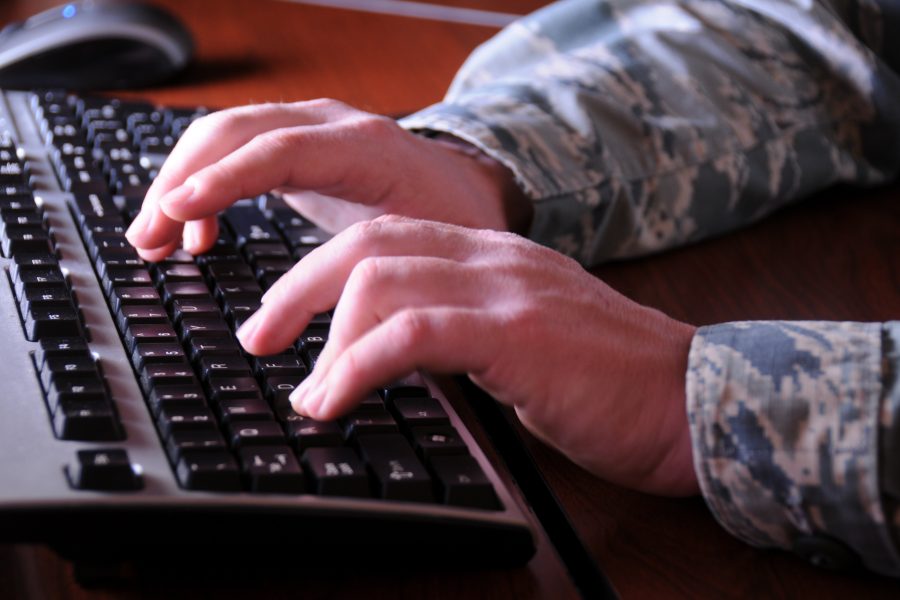As the May 31 deadline for Airmen to transfer into the Space Force quickly approaches, the new service is hashing out how to incorporate offensive cyber operations into its future combat plans and charting a path forward for cyber warriors who transfer in, officials said during a recently livestreamed town hall.
The Space Force at first is looking at bringing in about 130 cyber officers and around 1,000 enlisted members. Those transfers will largely handle defensive cyber operations, though Space Force cyberspace operations division chief Col. Aaron Gibson indicated that may change.
Offensive cyber operations are “definitely something we’re looking at as we’re starting to write our cyber strategy,” Gibson said May 7. Having that option is a priority for senior leaders who are embracing cyber as part of a broader information warfare strategy. Cyber operations can take out threats before they have a chance to harm the U.S., and offer a way to strike adversaries without turning to traditional explosives.
USSF cyber operators would still continue to handle typical space-focused missions like protecting communications transmissions, assuring the ability to control satellites, working in U.S. Cyber Command-affiliated mission defense teams, partnering with the National Reconnaissance Office, and more. But the service is also offering them a chance to work more closely with space operators, like those who manage satellites, and to do more with less by using emerging technology such as artificial intelligence.
The Space Force suggests AI can help humans defend more than 180 space mission systems for which there aren’t enough people to handle the cyber workload. The service plans to overcome that by collecting data from the systems and sending it to the Cyber Defense Correlation Cell for Space for analysis. The cell stood up last year as an operations center tailored to respond to cyber threats.
Space Force Operations and Communications Director Brig. Gen. Deanna Burt indicated the Space Force could consider replacing some of its contractors that do maintenance and other work on assets like ground-based radars with USSF personnel.
Cyber personnel are promised more stability with fewer, focused deployments and extended tour opportunities as part of the USSF. Peterson, Schriever, and Buckley Air Force Bases in Colorado, Los Angeles and Vandenberg Air Force Bases in California, and Patrick Air Force Base, Fla. will serve as the prime locations for cyber operators, but those same people will be needed around the world in the various combatant commands as well.
Schriever will stand up the equivalent of a cyber wing, run by a colonel, in the next few months to offer cyber support to space forces. It will not be called a wing as in the Air Force, but the Space Force has not announced what it will name many of its various organizational pieces or its ranks.
Officials did shed some light on structural changes happening within the new service. For one, the Space Force wants to do away with group-level leadership to flatten the bureaucracy. In another example, cyber professionals would be part of each base’s installation management team but would move away from running workplace information technology systems.
“You will have installation commanders, with comm squadrons initially assigned to those installation commanders to provide that base operating support,” Gibson said. “Those squadrons will essentially morph into a flight to provide that enterprise support or coordination with the [IT] service providers.”
Burt added the Space Force’s first basic military training course starts Oct. 7, though it’s unclear how it will differ from the Air Force’s BMT regime or where it will be held.
The Space Force’s first, and perhaps only, transfer window for Airmen closes May 31. While military officials have urged Airmen not to miss their chance to join the service, Burt indicated there are other ways to bring people in if they didn’t apply for a Space Force job during the month of May.
“There are many levers that the personnel system can use to try to look at, how do they level and fill out the appropriate grades and ranks if we don’t get what we need in this process or the total numbers that we need,” she said.
The burning question still on everyone’s mind: What will Space Force members be called?
“We were really hoping that that was going to get announced yesterday [May 6] with [Air Force Secretary Barbara Barrett and Chief of Space Operations Gen. Jay Raymond] on the webinar they did yesterday, but it did not,” Burt said. “There’s a lot of options out there, vanguards, sentinels, troopers, there’s been a ton of names that have been put forward. … I expect very soon we’re going to have that.”

